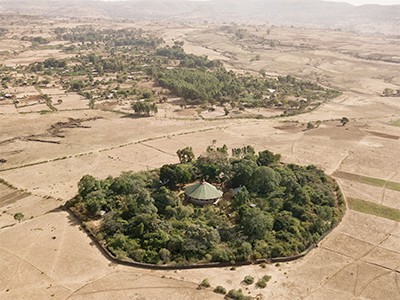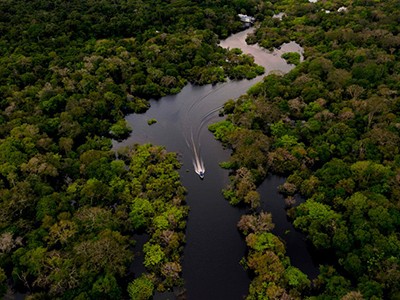
Jorge Lengua and his son (also Jorge) do not need to cut down trees to harvest Brazil nuts in the Bolivian Amazon.Credit: Martin Silva/AFP/Getty
The world’s forests are vital to its future. In terms of climate change, they are increasingly seen as key to both mitigation — in their role as carbon sinks — and adaptation, through sustainable management of forests. Tied in with both is the funding provided by those looking to offset carbon dioxide emissions by planting trees, a source of much-needed climate finance.
It is, therefore, unsurprising that ‘climate change’ and ‘climate finance’ are terms that dominate studies in forestry policy, according to a review of the literature published last week (see go.nature.com/4decszc). That, in itself, need not be a problem. But one stark conclusion from the report is that too few studies focus on the people who live in, or who make a living from, forests.
Swathes of Earth are turning into desert — but the degradation can be stopped
This finding should be taken on board by science funding agencies and the United Nations-affiliated research networks for biodiversity and climate change. And it should be taken into account when research priorities are set and collaborations are formed. Quite aside from the ethical case for more community-focused forestry policy, forest conservation is unlikely to succeed without the involvement of those most closely associated with forests.
The review is published by the International Union of Forest Research Organizations (IUFRO), a global body representing more than 600 institutions across over 100 countries. It assesses mostly English-language social-science literature published between 2011 and 2022 — covering the period since the last such review, in 2010. The authors find that the literature is dominated by the climate-mitigation interests of governments in high-income countries. They dub this the ‘financialization’ and ‘climatization’ of the literature surrounding forest policy.
This trend can be explained partly by the fact that forests are increasingly being incorporated into climate policies at all levels of governance — not least because of legally binding targets set by the 2015 Paris climate agreement. Forests are seen as providing the path of least resistance to achieving these targets, because their involvement requires little in the way of behaviour change from high-income countries. This has led to an expanding array of forest-related climate agreements at both regional and global levels. The largest of these is REDD+, through which low- and middle-income countries are paid (by companies and governments in high-income countries) to protect their forests. In return, contributors benefit from associated carbon credits. By the end of 2023, projects covered by REDD+ encompassed more than 60% of the forested area of developing countries. The scheme is not without controversy, with studies showing that carbon offsets can be overstated1 and have little impact on the economic well-being of forest communities2.
Biodiversity thrives in Ethiopia’s church forests
Forest agreements rely on the research community for support. Take REDD+ again. Some scientists are looking at ways to measure how carbon is stored in different forests; others are working on verifying that countries comply with climate commitments. Researchers also sit on scientific advisory committees.
But there’s more to the study of forest governance than climate. For example, there’s the matter of how Indigenous and local knowledge contribute to biodiversity conservation today. And there are studies of the various ecotourism schemes being set up. But these subjects are less well-represented in the literature.
Researchers in such fields do advise on forest-related international agreements not linked directly to climate change. These include the UN Convention on Biological Diversity and the UN Forum on Forests (UNFF), a global body dedicated to discussing a wide range of forest-related issues. But the UNFF is a voluntary arrangement; unlike the UN conventions on biodiversity and climate change, its decisions have no legal force.
We must get a grip on forest science — before it’s too late
The UN biodiversity convention, whose member states have agreed to conserve 30% of Earth’s land, waters and coasts by 2030, draws on a wider set of research disciplines — not least through its scientific advisory body, IPBES, which incorporates studies in Indigenous and local knowledge into its work3. The convention also contains an explicit mandate to provide benefits for the people who rely on biodiversity for their livelihoods. However, the IUFRO review’s authors found that there is little coordination between the biodiversity convention and the UN’s climate convention — or between the researchers who advise these two bodies.
The review is far from the first to highlight that research that should aim to benefit all stakeholders instead focuses on areas that are priorities for the governments of high-income countries. This is an important and timely reminder. It should not be difficult for the researchers involved in the world’s largest scientific networks — the IPCC for climate and IPBES for biodiversity — to create a shared agenda for the study of forests that extends beyond climate change and climate finance. And, given the need for such action, funders should respond positively to such a proposal.
Earth’s forests have the potential to benefit people everywhere. Researchers, policymakers and funders must ensure that everyone’s needs are taken into account.

 Swathes of Earth are turning into desert — but the degradation can be stopped
Swathes of Earth are turning into desert — but the degradation can be stopped
 Is Africa’s Great Green Wall project withering?
Is Africa’s Great Green Wall project withering?
 Biodiversity thrives in Ethiopia’s church forests
Biodiversity thrives in Ethiopia’s church forests
 We must get a grip on forest science — before it’s too late
We must get a grip on forest science — before it’s too late





